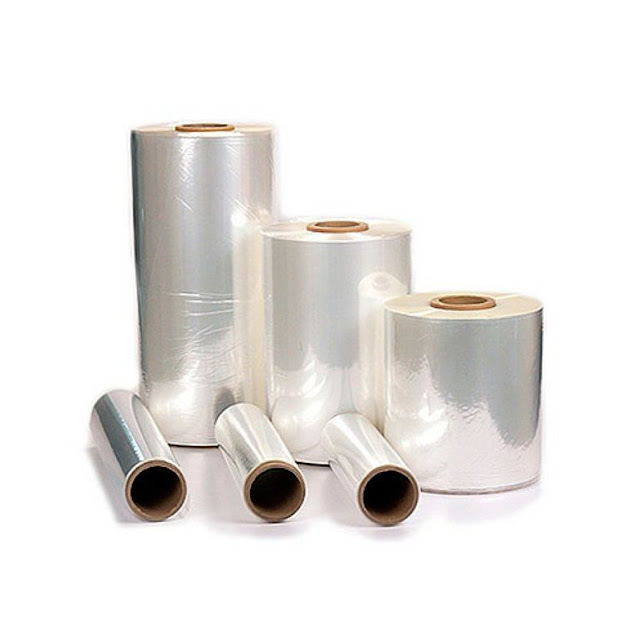Shrink Film
Shrink Film - a material made up of polymer plastic film.
When heat is applied, it shrinks tightly over whatever it is covering. There
are a variety of uses for Shrink wrap and shrink film. Some typical shrink wrap
applications are for wrapping food, gift baskets, boxes, toys, books, soaps,
etc. Below is a breakdown of the two most commonly used types of shrink.
PVC
Shrink Film - A type of shrink wrap used for various applications. The PVC
stands for Polyvinyl chloride. Polyvinyl chloride is the third most-produced
plastic in the world. PVC shrink wrap was the most used shrink film until
replaced several years ago by polyolefin (POF) shrink wrap.
Common Uses of PVC Shrink Film - PVC shrink wrap uses
include packaging boxes, CD and DVD packaging, software, small canisters, and
other non-edible items.
Drawbacks of PVC Shrink Film - Sealing Strength, storage
issues, and sealing by-products are common drawbacks of PVC Shrink Wrap. The
plasticizer in PVC Shrink wrap hardens in cold conditions and softens under hot
conditions, therefore compromising the strength of the seal and the plastic.
PVC shrink wrap also releases small quantities of hydrogen chloride into the
air and carbon deposits onto the sealer. Proper ventilation is required when
sealing PVC shrink wrap.
Polyolefin
Shrink Film - A type of shrink wrap that has become the preferred choice
for packaging products, both edible and non-edible. Polyolefin Shrink wrap is
preferred for a variety of reasons, including fewer odors when sealed, stronger
seal, and more flexible storage. Polyolefin shrink films do not have any
chlorine; therefore, they do not produce hydrogen chloride gas. Polyolefin
shrink wrap does not have any plasticizers, so the temperature is not an issue.
Polyolefin can be stored in a wide range of temperatures and does not harden
and soften in different environments like PVC shrink film.
Common Uses of Polyolefin Shrink Film - Polyolefin shrink
film is used for every kind of application. Applications include toys, sporting
goods, printed wrap, foods, stationery, and cards, just to name a few.
Drawbacks of Polyolefin Shrink Film - Cost and machine
compatibility are the two significant drawbacks of Polyolefin shrink film.
Polyolefin is commonly more expensive than PVC shrink wrap. Many packagers
prefer PVC because of this reason. There are types of polyolefin shrink wrap
that are more compatible with machines, but Polyolefin machine compatibility
has been an issue of packagers.
Cross-Linked
Polyolefin Shrink Film - Irradiation is applied to standard polyolefin
shrink film to make the film stronger, and capable of better seal strength. Cross-linked
shrink film is sterile, and FDA approved for direct food contact. It offers
excellent clarity to display packaged products.
Cross-linked shrink film also leaves less residue on
sealers, promoting longer sealing blade or wire life. Cross-linked shrink film
is made for use with high-speed machines and high output operations.
Common Uses of Cross-Linked Polyolefin Shrink Film -
Cross-linked shrink film is used with the same products as standard polyolefin
shrink film. The cross-linked film is often used in high output operations. It
can also be used for heavier products; a conventional polyolefin shrink film cannot
correctly package.
Drawbacks of Cross-Linked Polyolefin Shrink Film -
Cross-linked shrink film requires higher seal and shrink temps than a standard
polyolefin shrink film. Higher temperatures can damage and deform products
sensitive to heat. Higher seal and shrink temps. also, require higher energy
costs.
Polyethylene Shrink Film- Polyethylene shrink film is used
for packaging heavier products. Polyethylene shrink film (bundling film) is
most often extruded onto single wound or flat rolls. The rolls are used on
shrink bundling machines that have a sealing bar and shrink tunnel.
Drawbacks of Polyethylene Shrink Film - Polyethylene shrink
film requires a shrink bundling machine to run products efficiently. Shrink
bundling machines with a shrink tunnel can be expensive and cost thousands.
Polyethylene shrink film also requires more prolonged heat exposure to shrink
fully. Products sensitive to heat can melt or become damaged while the shrink
film is obtaining a full shrink. Polyethylene shrink film has a low shrink rate
of 15% or less. Product measurements are essential to ensure the right size of
shrink roll is purchased.
Call us at 813 242 6995 to discuss you shrink
application.




Comments
Post a Comment